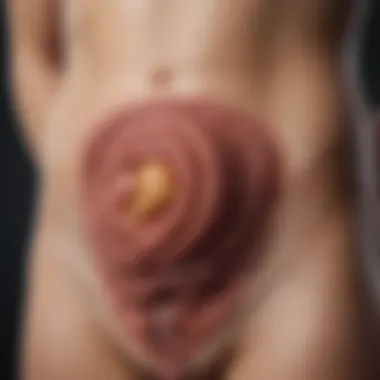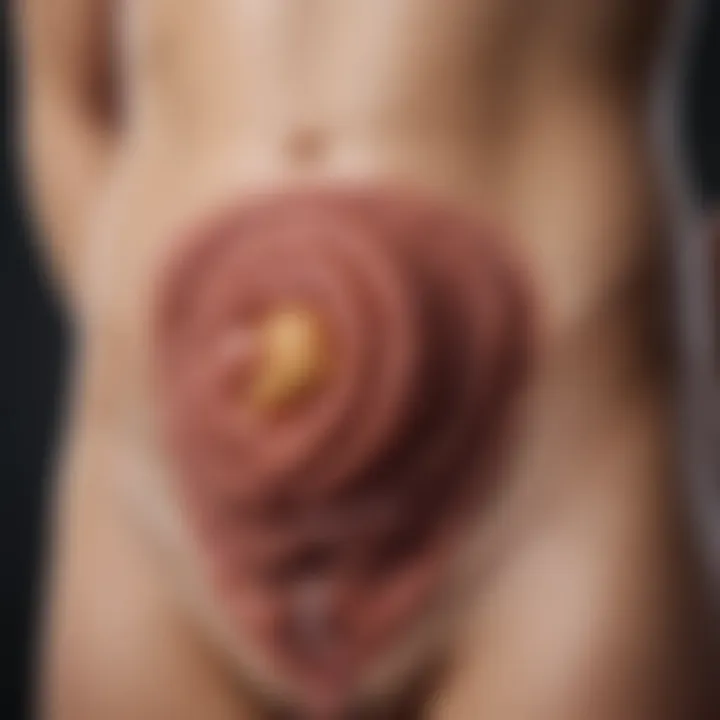Stomach Ulcers: Understanding Causes, Symptoms, Treatments


Intro
Stomach ulcers, or peptic ulcers, are sores that develop on the lining of the stomach or the upper part of the small intestine. They are more prevalent than many realize, affecting a significant portion of the population. Understanding their causes, symptoms, and treatments is essential for effective management and prevention.
Research Overview
Summary of Key Findings
Research in recent years emphasizes that stomach ulcers are primarily linked to two main factors: Helicobacter pylori infection and prolonged use of nonsteroidal anti-inflammatory drugs (NSAIDs). Other contributors include excessive alcohol intake and stress. Studies show that approximately 75% of peptic ulcers are associated with H. pylori, indicating the important role of this bacterium in ulcer development.
Additionally, lifestyle choices such as diet and stress management play a significant role in the prevention and recurrence of ulcers. The interplay between these factors warrants further exploration.
Relevance to Current Scientific Discussions
The ongoing discussions in the scientific community focus on the evolving understanding of ulcer pathophysiology and the implications for treatment strategies. Advancements in diagnostic techniques, such as endoscopy and urea breath testing for H. pylori, have improved ulcer detection. Moreover, the development of more effective treatment regimens continues to be an area of intensive research.
Such discussions are vital for students and medical professionals as they navigate the complexities of gastrointestinal health. An integrated approach to understanding ulcers encourages interdisciplinary study, merging fields such as gastronomy and pharmacology.
Methodology
Research Design and Approach
The research on stomach ulcers employs a combination of observational studies and clinical trials. Many studies utilize longitudinal designs to track the outcomes of various treatment protocols over time, providing deeper insights into their effectiveness.
Data Collection and Analysis Techniques
Data is typically collected through patient questionnaires, clinical examinations, and laboratory tests. Researchers often analyze this data using statistical software, which enables a robust assessment of treatment efficacy and symptom prevalence. This mixed-method approach enriches the understanding of how different factors contribute to ulcer formation and healing.
Understanding these methodologies offers a valuable perspective for those studying or practicing in the health sciences. This insight can help shape future research and clinical practices regarding stomach ulcers.
Prologue to Stomach Ulcers
Understanding stomach ulcers is essential for grasping their impact on health and the overall gastrointestinal system. These ulcers, often referred to as peptic ulcers, can lead to significant discomfort and complications if not managed properly. Knowledge about their causes, symptoms, and treatment options benefits a wide range of individuals, including patients, healthcare professionals, and researchers. By illuminating this topic, we can foster effective communication about prevention and management strategies, which can ultimately enhance the quality of life for those affected.
Definition of Stomach Ulcers
Stomach ulcers are painful sores that develop on the lining of the stomach. They fall under the broader category of peptic ulcers, which also includes ulcers that occur in the upper part of the small intestine and the esophagus. These lesions can arise when the protective mucosal layer of the stomach is disrupted, often necessitating close medical attention. The presence of such ulcers is usually confirmed through diagnostic procedures, which yield critical information about their nature and extent.
Historical Context
The understanding of stomach ulcers has evolved significantly through history. Traditionally, ulcers were often associated with certain eating habits and stress levels. However, advancements in medical science throughout the 20th century shifted this perception. In the 1980s, the discovery of Helicobacter pylori as a primary cause of many peptic ulcers revolutionized treatment approaches. Before this breakthrough, treatments largely focused on lifestyle modifications and the use of antacids. Today, the relationship between lifestyle choices, medication usage, and the incidence of ulcers is recognized as multifaceted, making historical insight valuable in the ongoing research into stomach ulcers.
"A deeper understanding of historical trends in stomach ulcer research allows for informed strategies in both prevention and treatment."
As we delve deeper into stomach ulcers, it will be crucial to explore the various types, their etiology, and how these factors interact with the symptoms and treatments available.
Types of Stomach Ulcers
Understanding the types of stomach ulcers is crucial for both diagnosis and treatment. Each type has distinct characteristics and implications for patient management. Recognizing these differences allows healthcare providers to tailor treatment approaches effectively.
Gastric Ulcers
Gastric ulcers occur in the lining of the stomach. They are formed when the protective mucus layer is diminished, allowing stomach acid to damage the underlying tissue. This type is often linked to Helicobacter pylori infection or prolonged use of nonsteroidal anti-inflammatory drugs (NSAIDs). Symptoms of gastric ulcers can include a burning pain in the stomach, which may worsen after meals. Understanding gastric ulcers is vital, as they can lead to complications like bleeding or perforation if left untreated.
Duodenal Ulcers
Duodenal ulcers are found in the duodenum, the first part of the small intestine. They are more prevalent than gastric ulcers and frequently associated with Helicobacter pylori as well. Patients may experience pain that often occurs between meals or during the night, typically relieved by eating. Knowing the distinct features of duodenal ulcers can aid in differentiating them from gastric ulcers, which is important for determining the correct treatment. These ulcers can also lead to complications, including gastrointestinal bleeding and obstruction.
Esophageal Ulcers
Esophageal ulcers are less common but can occur due to acid reflux or chronic inflammation. These ulcers develop in the esophagus and may be caused by factors such as certain medications or Gastroesophageal Reflux Disease (GERD). Symptoms often include difficult swallowing, heartburn, or chest pain. Treatment for esophageal ulcers addresses the underlying causes, often focusing on reducing acid production and healing the ulcer. Recognizing esophageal ulcers is critical, as they can significantly affect a person's quality of life.
Etiology of Stomach Ulcers
The etiology of stomach ulcers is crucial in understanding their formation and development. Grasping the underlying causes permits both effective prevention and targeted treatment. Stomach ulcers, also known as peptic ulcers, can arise due to various factors, including infections, medications, stress, and lifestyle choices. Each of these components plays a significant role in the ulcer formation process. Without this knowledge, individuals might overlook warning signs or continue behaviors that exacerbate their condition.


Helicobacter Pylori Infection
A primary contributor to stomach ulcers is Helicobacter pylori, a type of bacteria. This organism lives in the acidic environment of the stomach and can damage the mucosal lining. Infection with H. pylori is common; many people may carry it without ever developing an ulcer. If the bacteria disrupt the stomach's balance, it can provoke inflammation, leading to ulceration.
The diagnosis of H. pylori typically involves non-invasive tests such as breath, stool, or serology assays. Treatments usually include antibiotics combined with proton pump inhibitors (PPIs) to reduce stomach acid, thus supporting ulcer healing.
Nonsteroidal Anti-Inflammatory Drugs (NSAIDs)
Another significant factor in ulcer development is the use of nonsteroidal anti-inflammatory drugs. Common medications like ibuprofen and naproxen can irritate the stomach lining. Chronic use of NSAIDs can lead to the inhibition of prostaglandins, which are substances that help protect the stomach mucosa. This reduction in protective mechanisms makes the stomach more susceptible to damage from gastric acid.
It is crucial to use these medications cautiously and explore alternatives for pain management when necessary. Consulting with health professionals about the potential risks is advisable, especially for those needing long-term pain relief.
Stress and Its Mechanisms
Stress has often been linked to ulcer formation, although its precise role is complex. Chronic stress can lead to excessive stomach acid production. It can contribute to unhealthy eating habits, like overeating or consuming more irritants such as alcohol and caffeine. Stress does not directly cause ulcers but can exacerbate existing conditions and hinder healing processes.
Implementing stress management techniques can help reduce the likelihood of developing ulcers. Techniques such as mindfulness, relaxation strategies, and behavior modification can be beneficial.
Lifestyle Factors
Lifestyle choices significantly influence the risk of stomach ulcers. Factors like diet, alcohol consumption, and smoking contribute to ulcer risk. High consumption of spicy and fatty foods can irritate the stomach lining. Moreover, excessive alcohol intake can damage the mucosal barrier and increase acid secretion, leading to ulcers.
Smoking poses another risk, as it can impair blood flow to the stomach lining and reduce mucosal defense. Thus, individuals at risk or experiencing symptoms should consider evaluating their lifestyle choices and making necessary adjustments to mitigate these factors.
"Awareness of etiology is fundamental in preventing and managing stomach ulcers effectively."
Understanding these elements is vital for anyone looking to prevent or combat stomach ulcers, highlighting the need for a comprehensive approach to health and wellness.
Symptoms of Stomach Ulcers
Understanding the symptoms of stomach ulcers is crucial for early diagnosis and appropriate treatment. This section emphasizes the need for awareness regarding clinical manifestations that can arise from stomach ulcers. Recognizing the symptoms can lead to timely medical intervention, preventing further complications. Additionally, a discussion of symptoms helps individuals attribute their discomfort to potential underlying issues related to stomach health.
Common Clinical Manifestations
Stomach ulcers often present with a variety of symptoms that vary in severity and frequency among individuals. Some of the most common clinical manifestations include:
- Abdominal Pain: A burning or gnawing sensation in the stomach area is prevalent. This pain might be relieved temporarily by eating or taking antacids.
- Nausea and Vomiting: Individuals may experience feelings of nausea that can escalate to vomiting. This symptom can be indicative of ulcer-related complications.
- Indigestion or Dyspepsia: Many people report a sense of bloating, burping, and general discomfort after meals.
- Loss of Appetite: Reduced desire to eat can occur, often linked to anticipated pain after meals.
- Weight Loss: Unintentional weight loss may follow from a combination of nausea, loss of appetite, and fear of eating due to pain.
In some cases, the symptoms can worsen or change, signaling complications such as bleeding or perforation. It is important for patients to monitor their symptoms and consult a healthcare provider.
Complications Associated with Stomach Ulcers
Stomach ulcers can lead to severe complications if left untreated. Awareness of these potential consequences reinforces the significance of timely treatment. Some complications include:
- Internal Bleeding: This can present itself as dark or black stools, or vomit that resembles coffee grounds. This condition necessitates immediate medical attention.
- Perforation: A serious and potentially life-threatening condition where the ulcer creates a hole in the stomach wall. This leads to infection and severe abdominal pain.
- Gastric Outlet Obstruction: Swelling from an ulcer may restrict food passage into the small intestine, resulting in vomiting and weight loss.
"Prompt recognition of ulcer symptoms can considerably reduce the risk of complications."
Being informed about these symptoms and associated complications empowers individuals to seek the necessary care.
In summary, understanding the symptoms of stomach ulcers is essential for effective management and treatment. Early identification improves patient outcomes and decreases the likelihood of severe complications.
Diagnosis of Stomach Ulcers
Diagnosing stomach ulcers is a critical step in the management of this condition. Accurate diagnosis leads to effective treatment plans and can help prevent serious complications. The importance of understanding various diagnostic methods cannot be overstated. They provide a way for healthcare professionals to confirm the presence of ulcers and to differentiate between types of gastrointestinal disorders that may present with similar symptoms.
A thorough evaluation often starts with a patient’s medical history and symptom assessment. Common complaints include abdominal pain, indigestion, and bloating. Once these initial assessments are made, further diagnostic techniques come into play to visualize the region of concern.
Endoscopy Procedures
Endoscopy is a key procedure used to diagnose stomach ulcers. This technique involves inserting a flexible tube with a camera, known as an endoscope, into the digestive tract. It allows the doctor to view the lining of the stomach in real-time. The procedure is valuable because it not only helps in identifying ulcers but also provides the opportunity to take biopsy samples if necessary.
Benefits of Endoscopy:
- Direct Visualization: Enables direct observation of ulcers.
- Biopsy Capability: Allows for tissue sampling to test for Helicobacter pylori or cancerous cells.
- Therapeutic Options: Can facilitate immediate treatment such as cauterization of bleeding ulcers.
However, while effective, endoscopy does come with risks like bleeding and infection. Patient comfort is another consideration. Pre-procedure sedation is typically offered, creating a more manageable experience for the individual undergoing the test.


Imaging Techniques
Various imaging techniques complement endoscopy in diagnosing stomach ulcers. Among these techniques, X-rays and CT scans are the most frequently used. Barium swallow studies are also common. In this procedure, the patient ingests a barium solution, which highlights the digestive tract on X-rays.
Advantages of Imaging Techniques:
- Non-Invasive: Techniques like X-rays do not require physical intervention, thus presenting less risk than endoscopy.
- Detailed Imaging: CT scans provide an in-depth look at the gastrointestinal system, helping to identify complications.
- Helpful for Obstructions: Imaging can show blockages or other abnormalities in the digestive system that may accompany ulcers.
Despite their benefits, imaging techniques usually do not allow for the same level of direct intervention or diagnosis that endoscopy offers. They are often used in combination with other diagnostic methods to provide a comprehensive view of the patient’s condition.
Laboratory Tests
Laboratory tests can play a crucial role in diagnosing stomach ulcers. Blood tests and stool tests are particularly common. These tests aim to detect indicators of infection, anemia, or other relevant conditions.
Key Laboratory Tests Include:
- Helicobacter pylori Testing: Tests such as breath tests, stool antigen tests, and blood tests can identify this bacterium, which is a leading cause of ulcers.
- Complete Blood Count (CBC): Measures hemoglobin levels to check for anemia, a possible consequence of bleeding ulcers.
- Stool Tests: Help determine the presence of blood in the stool, an indicator of ulcer complications.
While laboratory tests can assist in confirming the diagnosis, they are typically used alongside imaging and endoscopy for a more complete understanding of the ulcer's etiology.
In summary, the diagnosis of stomach ulcers involves a multidimensional approach. Each method contributes unique insights and is aimed at streamlining treatment and mitigating risks.
By understanding the strengths and weaknesses of these diagnostic options, patients and healthcare providers can make informed choices about the appropriate path forward in managing stomach ulcers.
Treatment Options for Stomach Ulcers
Treatment for stomach ulcers is crucial for reducing discomfort and preventing complications. This section delves into various approaches for managing ulcers, providing insights into medication, surgical options, and lifestyle changes. Understanding the available treatments can empower individuals to make informed decisions regarding their health.
Medications for Ulcer Healing
Medications play a vital role in promoting the healing of stomach ulcers. The most common types of medications include proton pump inhibitors (PPIs), -receptor antagonists, and antacids.
Proton Pump Inhibitors, such as omeprazole and lansoprazole, reduce stomach acid production significantly. This allows the ulcerated tissue to heal more effectively.
-receptor antagonists, like ranitidine and famotidine, also decrease acid secretion but are generally less potent compared to PPIs. These medications can be particularly useful for milder cases or as a preventive measure.
Antacids neutralize existing stomach acid, providing immediate relief to symptoms. They are often used in combination with other treatments.
These medications not only facilitate healing but also provide symptomatic relief, improving the overall quality of life for patients.
Surgical Interventions
In some cases, surgery may be required. Surgical interventions are typically considered when ulcers fail to respond to medication or if there are serious complications such as bleeding or perforation. Procedures may involve removing the ulcer or a part of the stomach to decrease acid production. The main surgical options include:
- Vagotomy: Cutting the vagus nerve can reduce acid production.
- Pyloroplasty: This procedure involves widening the opening of the stomach to aid in food passage and reduce stomach pressure.
- Partial Gastrectomy: This is the removal of part of the stomach, which can be beneficial in severe cases.
Surgery can lead to long-term relief from symptoms, but it requires patient's commitment to post-operative care and lifestyle adjustments.
Lifestyle Modifications
Adjusting lifestyle factors can greatly benefit those with stomach ulcers. These modifications aim to reduce symptoms, speed up healing, and prevent recurrence. Key changes include:
- Dietary Modifications: Opt for a balanced diet rich in fiber and low in spicy or acidic foods. Consumption of probiotic-rich foods may also support gut health.
- Avoid Smoking and Alcohol: Both substances can exacerbate ulcer symptoms and hinder healing. Quitting smoking and reducing alcohol intake is essential for recovery.
- Stress Management: Engaging in regular stress-reduction strategies such as yoga, meditation, or deep breathing exercises can alleviate gastrointestinal discomfort.
Incorporating these lifestyle changes alongside medical treatment enhances healing and promotes overall digestive health.
By understanding the treatment options available, individuals can take proactive steps towards managing their stomach ulcers effectively.
Prevention Strategies for Stomach Ulcers
Preventing stomach ulcers is crucial for maintaining gastrointestinal health. Stomach ulcers, or peptic ulcers, can lead to serious complications if left untreated. By focusing on proactive strategies, individuals may significantly reduce their risk of developing these painful sores. It's essential to recognize the interconnectedness of various lifestyle elements that contribute to ulcer formation. This section will detail dietary considerations, the importance of ceasing alcohol and smoking, and the implementation of effective stress management techniques.
Dietary Considerations
Dietary choices play a significant role in ulcer prevention. Consuming a balanced diet rich in nutrients can help maintain the integrity of the stomach lining. Key elements to consider include:


- Fruits and Vegetables: These are high in antioxidants, vitamins, and minerals which promote healing and reduce inflammation.
- Fiber: Whole grains, legumes, and nuts can aid in digestive health, ultimately protecting the stomach lining.
- Probiotics: Foods like yogurt and fermented items can boost gut health. They may help suppress Helicobacter pylori, a common bacteria associated with ulcer formation.
It's wise to limit certain foods that may irritate the stomach. Spicy foods, high-fat items, and acidic products should be monitored. Hydration is also important; drinking adequate water throughout the day aids digestion.
Alcohol and Smoking Cessation
Both alcohol consumption and smoking are significant risk factors for stomach ulcers. Alcohol can increase stomach acid production and irritate the mucosal lining. Therefore, moderating intake or abstaining entirely is advisable. Quitting smoking is equally critical; it can impair the stomach’s ability to heal and increase acid production.
- Benefits of Ceasing:
- Decreases gastric acid secretion.
- Promotes healing of the stomach lining.
- Reduces the risk of disease progression.
Support systems, such as cessation programs or counseling, can enhance the chances of successful cessation.
Stress Management Techniques
High stress levels can exacerbate stomach ulcer conditions. Practicing effective stress management can be beneficial. Various techniques can help mitigate stress, including:
- Meditation and Mindfulness: These practices help in centering thoughts and reducing anxiety.
- Regular Exercise: Physical activity releases endorphins, which improve mood and reduce stress.
- Breathing Exercises: Simple breathing techniques can enhance relaxation and thus help control stomach acid production.
Incorporating these practices into daily life can result in improved overall well-being. A balance of mental, emotional, and physical health plays a crucial role in prevention.
Through appropriate choices and interventions, a proactive stance can help in not only preventing ulcers but also in fostering long-term health.
Impact of Stomach Ulcers on Quality of Life
Stomach ulcers can significantly influence an individual's quality of life. Understanding the impact of this gastrointestinal condition goes beyond recognizing its physical symptoms. It encompasses how the ulcers affect daily activities, mental health, and overall well-being. Addressing the repercussions of stomach ulcers is essential, as their effects can disrupt an individual’s physical and emotional life.
Physical Health Consequences
Stomach ulcers are not just isolated issues; they lead to various physical health consequences that can diminish a person's quality of life. Common manifestations include:
- Chronic Pain: Ulcers can cause persistent abdominal pain and discomfort. This pain may vary in intensity and frequency, often leading to anxiety regarding meals or physical activities.
- Nausea and Vomiting: Individuals with stomach ulcers often experience nausea, which can result in vomiting. This condition makes it difficult to maintain proper nutrition, further complicating health issues.
- Anemia: Ulcers can lead to internal bleeding, resulting in anemia. Symptoms like fatigue, weakness, and pallor can arise. This condition affects energy levels and general health, complicating everyday tasks.
- Weight Fluctuations: Due to pain or nausea, some individuals may lose weight unintentionally. Others may experience weight gain due to comfort eating. Such fluctuations can have long-term health implications.
Having a stomach ulcer also requires constant management. Regular doctor visits and adherence to medication regimens can consume time and resources, which may contribute to stress and anxiety. This ongoing nature of treatment can further distract an individual from other important aspects of life.
Psychosocial Factors
The psychosocial impact of stomach ulcers deserves attention. Individuals suffering from this condition may experience a range of emotional and mental health issues:
- Anxiety and Depression: The chronic pain and discomfort associated with stomach ulcers can lead to or exacerbate mental health conditions. Anxiety regarding symptoms can be overwhelming and lead to social withdrawal.
- Social Withdrawal: Fear of embarrassment from symptoms often causes people to avoid social situations. This isolation can intensify feelings of loneliness and depression, diminishing overall life satisfaction.
- Changes in Lifestyle: With the fear of triggering ulcer pain, patients may change their dietary habits, often limiting their food choices. This restriction can affect social eating occasions, impacting relationships and enjoyment of life.
- Work Implications: Ulcers might lead to absenteeism or decreased productivity at work. This situation can create economic stress, further affecting one's mental health.
In summary, the impact of stomach ulcers is significant. The physical health consequences affect daily functioning, while psychosocial factors can hinder emotional and social engagement. Recognizing these challenges emphasizes the need for a comprehensive approach to treatment and support, both physically and mentally.
Recent Advances in Stomach Ulcer Research
Research into stomach ulcers is crucial in the ongoing effort to improve healthcare outcomes for affected individuals. Understanding the complexities of stomach ulcers has evolved significantly over the years. With new findings, scientists gain insights into effective treatments, prevention strategies, and overall patient care. This section highlights novel therapeutic approaches and ongoing clinical trials, uncovering how they shape the future of ulcer management.
Novel Therapeutic Approaches
Recent advancements have led to the development of innovative treatment options for stomach ulcers. These include the exploration of new medications and alternative therapies that go beyond traditional options. One noteworthy development involves the utilization of bioactive compounds derived from natural sources. For instance, certain plant extracts have shown promise in enhancing mucosal healing and reducing ulcer recurrence. Researchers are now focusing on molecular mechanisms that govern ulcer healing to identify potential drug targets.
Another promising area is the use of probiotics. These beneficial bacteria can aid in restoring the gut microbiome's balance. By improving gut health, probiotics may play a role in reducing ulcer formation and promoting healing. Early clinical studies show encouraging results, which suggest that integrating probiotics into treatment regimens could enhance ulcer recovery.
"Incorporating novel therapies into the treatment landscape can significantly improve patient outcomes for those suffering from stomach ulcers."
Ongoing Clinical Trials
Clinical trials are essential for validating new treatments and understanding their effectiveness. Numerous trials are currently investigating various approaches to manage stomach ulcers more effectively. These trials examine new drug formulations, combination therapies, and even the potential of immunotherapy. Immunotherapy, while traditionally associated with cancer treatment, is being explored for its potential to modulate the immune response involved in ulcer development.
Moreover, several studies focus on patient-centered outcomes, evaluating not just healing rates but also quality of life factors. This comprehensive approach ensures treatments address the holistic needs of individuals. Clinical trials are also crucial in assessing the safety profiles of new medications, minimizing the risks associated with existing therapies.
Culmination
Understanding stomach ulcers is crucial for effective management and prevention of this common gastrointestinal issue. This article has shed light on the various dimensions of stomach ulcers, from their causes and symptoms to treatment options and their impact on quality of life. Addressing these aspects holistically provides valuable insights for practitioners, researchers, and patients alike.
Summarizing Key Points
Stomach ulcers are primarily caused by factors like Helicobacter pylori infection and the use of nonsteroidal anti-inflammatory drugs. The symptoms can range from mild discomfort to severe complications that affect overall health. Diagnosis typically involves endoscopy and imaging techniques which play a pivotal role in determining the severity and nature of the ulcer. Treatment remains multi-faceted, including a combination of medications, lifestyle changes, and in some cases, surgical intervention. Prevention strategies, such as dietary adjustments and stress management, help mitigate the risk of developing ulcers. Understanding these key points lays the groundwork for improved patient outcomes.
Future Directions in Ulcer Management
The landscape of ulcer management is evolving with ongoing research focused on novel therapeutic approaches. Future treatments may include targeted therapies aimed at eradicating Helicobacter pylori more effectively. Additionally, increasing awareness about lifestyle factors and personalized medicine could lead to tailored strategies for individuals. Clinical trials are critical in developing these new strategies, ensuring that they are both safe and efficient. Researchers are also exploring the role of probiotics and diet in ulcer prevention, which may provide new avenues for maintaining gastrointestinal health in at-risk populations. Emphasizing these future directions is essential for propelling the field forward and improving patient care.



